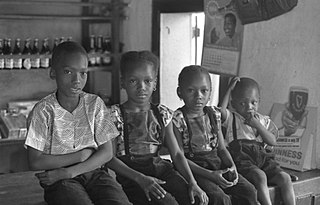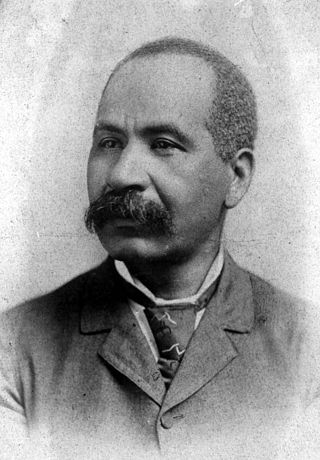Sierra Leone first became inhabited by indigenous African peoples at least 2,500 years ago. The Limba were the first tribe known to inhabit Sierra Leone. The dense tropical rainforest partially isolated the region from other West African cultures, and it became a refuge for peoples escaping violence and jihads. Sierra Leone was named by Portuguese explorer Pedro de Sintra, who mapped the region in 1462. The Freetown estuary provided a good natural harbour for ships to shelter and replenish drinking water, and gained more international attention as coastal and trans-Atlantic trade supplanted trans-Saharan trade.

Bunce Island is an island in the Sierra Leone River. It is situated in Freetown Harbour, the estuary of the Rokel River and Port Loko Creek, about 20 miles upriver from Sierra Leone's capital city Freetown. The island measures about 1,650 feet by 350 feet and houses a castle that was built by the Royal Africa Company in c.1670. Tens of thousands of Africans were shipped from here to the North American colonies of South Carolina and Georgia to be forced into slavery, and are the ancestors of many African Americans of the United States.

Sherbro Island is in the Atlantic Ocean, and is included within Bonthe District, Southern Province, Sierra Leone. The island is separated from the African mainland by the Sherbro River in the north and Sherbro Strait in the east. It is 32 miles (51 km) long and up to 15 miles (24 km) wide, covering an area of approximately 230 square miles (600 km2). The western extremity is Cape St. Ann. Bonthe, on the eastern end, is the chief port and commercial centre.

Sengbe Pieh, also known as Joseph Cinqué or Cinquez and sometimes referred to mononymously as Cinqué, was a West African man of the Mende people who led a revolt of many Africans on the Spanish slave ship La Amistad in July 1839. After the ship was taken into custody by the US Revenue-Marine, Cinqué and his fellow Africans were eventually tried for mutiny and killing officers on the ship, in a case known as United States v. The Amistad. This reached the U.S. Supreme Court, where Cinqué and his fellow Africans were found to have rightfully defended themselves from being enslaved through the illegal Atlantic slave trade and were released. The US government did not provide any aid to the acquitted Mende People. The United Missionary Society, a black group founded by James W.C. Pennington, helped raise money for the return of thirty-five of the survivors to Sierra Leone in 1842.

The Temne, also called Atemne, Témené, Temné, Téminè, Temeni, Thaimne, Themne, Thimni, Timené, Timné, Timmani, or Timni, are a West African ethnic group, They are predominantly found in the Northern Province of Sierra Leone. Some Temne are also found in Guinea. The Temne constitute the largest ethnic group in Sierra Leone, at 35.5% of the total population, which is slightly bigger than the Mende people at 31.2%. They speak Temne, a Mel branch of the Niger–Congo languages.
The Sherbro people are a native people of Sierra Leone, who speak the Sherbro language; they make up 1.9% of Sierra Leone's population or 134,606. The Sherbro are found primarily in their homeland in Bonthe District, where they make up 40% of the population, in coastal areas of Moyamba District, and in the Western Area of Sierra Leone, particularly in Freetown. During pre-colonial days, the Sherbro were one of the most dominant ethnic group in Sierra Leone, but in the early 21st century, the Sherbro comprise a small minority in the nation. The Sherbro speak their own language, called Sherbro language.
Thomas Canry Caulker (1846–1859), (Sherbro) was born into a prominent African family, and his father ruled as King of Bompey, an African polity established in 1820 in what is now Sierra Leone. Caulker is among an early generation of West Africans sent to England for their education. His father wanted him prepared for demands for government and commerce in his homeland, before the Sierra Leone Protectorate was established by Great Britain. His father's ambition for him was influenced by the evangelical Christianity in the region, introduced largely by British abolitionists.
Thomas Corker was known as an English agent for the Royal African Company on York Island. He married a Sherbro woman and had two sons with her before his early death.
Gbap is a small rural fishing town in Nongoba Bullom Chiefdom, Bonthe District in the Southern Province of Sierra Leone. The town is mainly inhabited by the Sherbro people. Gbap is the traditional home of the Sherbro Tuckers Family, descendants of an English slave trader and a Sherbro princess. It is also the birthplace of Patricia Kabbah, former First Lady of Sierra Leone and wife of Ahmad Tejan Kabbah, Sierra Leone's 3rd President.
John Tucker was an English slave trader for the Royal African Company from London, England.
John Kizell was an American immigrant to Sierra Leone, who became a leader in Sierra Leone as it was being developed as a new British colony in the early nineteenth century. Believed born on Sherbro Island, he was captured and enslaved as a child, and shipped to Charleston, South Carolina, where he was sold again. Years later, after the American Revolutionary War, during which he gained freedom with the British and was evacuated to Nova Scotia, he eventually returned to West Africa. In 1792 he was among 50 native-born Africans among the 1200 mostly African-American Black Loyalists who were resettled in Freetown.
Sierra Leoneans in the United Kingdom are citizens or residents of the United Kingdom who are of Sierra Leonean descent. In 2001, there were 17,048 Sierra Leonean-born residents of the UK.
Shenge is a coastal fishing town along the Atlantic ocean in Moyamba District, Southern Province, Sierra Leone. Shenge is the seat of the Kagboro Chiefdom, part of the third level of administration. The dense coastal jungle has prevented development of a good road network, and the Shenge is still most easily reached by boat. The local small fishing and passenger boats that travel among the coastal towns are known as pampas in Sierra Leone.
Henry Smeathman (1742–1786) was an English naturalist, best known for his work in entomology and colonial settlement in Sierra Leone.
Stephen Caulker was a king of the Banana Islands off the coast of present-day Sierra Leone. He had some distant Anglo-Irish ancestry and was mostly Sherbro in ancestry. Caulker was part of a hereditary dynasty that ruled as chiefs of the states of Bumpe and Shenge (Kagboro) in Sierra Leone from 1820 into the late 20th century.

Thomas DeSaille Tucker or Thomas DeSaliere Tucker was an African-born lawyer, educator, and missionary. He was the first president of the State Normal College for Colored Students, which eventually became Florida Agricultural and Mechanical University.

Sierra Leone is home to about sixteen ethnic groups, each with its own language. In Sierra Leone, membership of an ethnic group often overlaps with a shared religious identity.

The Saro, or Nigerian Creoles of the 19th and early 20th centuries, were Africans that were emancipated and initially resettled in Freetown, Sierra Leone by the Royal Navy, which, with the West Africa Squadron, enforced the abolition of the international slave trade after the British Parliament passed the Slave Trade Act 1807. Those freedmen who migrated back to Nigeria from Sierra Leone, over several generations starting from the 1830s, became known locally as Saro(elided form of Sierra Leone, from the Yoruba sàró). Consequently, the Saro are culturally descended from Sierra Leone Creoles, with ancestral roots to the Yoruba people of Nigeria.

The Sierra Leone Creole people are an ethnic group of Sierra Leone. The Sierra Leone Creole people are descendants of freed African-American, Afro-Caribbean, and Liberated African slaves who settled in the Western Area of Sierra Leone between 1787 and about 1885. The colony was established by the British, supported by abolitionists, under the Sierra Leone Company as a place for freedmen. The settlers called their new settlement Freetown. Today, the Sierra Leone Creoles are 1.2 percent of the population of Sierra Leone.
Richard Canreba Caulker (18??–1901), also known as Canrah Bah Caulker, was ruler of the Bumpe Chiefdom, 1864–1888 and 1894–1901. This area became incorporated into the Sierra Leone Protectorate in 1888, and is now part of the Moyamba District of the independent Sierra Leone nation.







